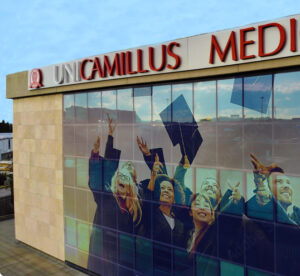Assessing the situation with Professor Francesco Cognetti, lecturer in Medical Oncology at UniCamillus
It is the second leading cause of death in the world (after cardiovascular disease), killing around 10 million people every year and costing 1.16 trillion dollars in global health care. We are talking about cancer. World Cancer Day was celebrated on 4 February, as it is every year.
The date was established on 4 February 2000, following a global summit in Paris that focused on the issue. The aim of World Cancer Day is to raise awareness of this sadly widespread disease, both by promoting research and by informing society about prevention and the availability of services for diagnosis and treatment.
As far as Italy is concerned, the Associazione Italiana di Oncologia Medica (AIOM)’s report “The numbers of cancer in Italy in 2023“ estimates 395 thousand new cases in 2023, with breast cancer continuing to be the most diagnosed neoplasm, followed by colorectal cancer, lung cancer, prostate cancer, and bladder cancer.
What is cancer?
The word “cancer” is an umbrella term which covers several types of neoplasms characterised by an abnormal and uncontrolled proliferation of cells with genetic mutations. Not all tumours are life-threatening: there are also benign tumours, which progress slowly and locally and whose cells are similar to healthy ones. Malignant tumours, on the other hand, grow rapidly and not only invade nearby tissues but can also metastasise to other organs.
Cancers also differ according to the type of cell from which they develop: while carcinomas arise from epithelial cells (such as breast, prostate, lung and colon cancer), sarcomas affect soft tissues such as fat (liposarcoma) and bone (osteosarcoma). Lymphomas and myelomas attack the immune system, preventing the body from producing antibodies to defend itself. Leukaemia is a blood cancer (affecting white blood cells and the bone marrow), while central nervous system tumours affect the brain and spinal cord.
Prevention and early detection
The good news is that “40% of tumours can be prevented by what is known as “primary prevention”, that is, by adopting the right lifestyle“, as Professor Francesco Cognetti, lecturer in Medical Oncology at UniCamillus, points out. A healthy behaviour involves simple but fundamental rules, namely:
- not smoking
- avoiding excessive alcohol consumption: a maximum of one glass of wine a day for women and two for men, while spirits should be avoided as much as possible. These recommendations apply to adults, while under-16s are strongly discouraged from drinking.
- taking regular physical exercise.
- maintaining a healthy weight.
- eating a healthy and balanced diet, especially avoiding red and processed meat.
- avoiding excessive exposure to ultraviolet radiation.
- avoiding environmental pollution as much as possible.
That said, cancer is not always preventable due to a significant influence of hereditary and genetic factors. For this reason, there is another type of prevention, called “secondary prevention”, which involves ongoing screening for certain types of tumours in order to allow early diagnosis and treatment. “Routine screening is usually done for specific types of cancer”, Cognetti points out. “For breast cancer, for example, mammography is recommended at least every two years for women between the ages of 45 and 75.
However, if there are other cases in the family that could indicate a familial predisposition, MRI is to be preferred from the age of 25″.
From the age of 45, screening for colorectal cancer is crucial for both men and women. “The possible presence of occult blood in the stools is checked with a specific test to be repeated every two years”, explains Cognetti. “However, for people at high risk because of a family history of this type of cancer, a colonoscopy is recommended every year or every two years”.
Another typical female cancer is cervical cancer, which in most cases is caused by infection with a high-risk strain of HPV (that’s short for human papillomavirus, usually transmitted sexually). Pap tests are recommended between the ages of 25 and 65 to detect any precancerous lesions. If the test is positive, further tests are done, otherwise the test is repeated after 3 years. A new screening test is based directly on the detection of high-risk HPV infection: the HPV test is performed from the age of 30 and should be repeated at intervals of about 5 years. If the test is positive, further tests are needed. “The best prevention is the HPV vaccine”, advises Cognetti, “which is highly recommended in adolescence, i.e. at an age before sexual activity”.
These three types of screening are active in Italy within the so-called LEA (that’s Essential Levels of Assistance), which means that the National Health Service offers all citizens the opportunity to do periodic check-ups, either by paying or free of charge.
“But there are also other important types of screening”, adds Cognetti. “For example, for smokers or ex-smokers, there is what we call the spiral CT scan of the lungs: this is a test that can detect any lumps when they are still limited and localised, making them easy to remove surgically; or prostate cancer screening, with the measurement of PSA levels— but this is still being studied”.
Early treatment can really save millions of lives, but public awareness is still too low: it is enough to think that the AIOM report recorded a 3% drop in compliance with screening in 2023.
“As for basic screening, after the collapse of adherence in 2020 during the pandemic, there was a slight recovery in 2021”, Cognetti explains. “Unfortunately, however, there was a further decline in 2022, with values between 35 and 40% of the national average, with very low estimates for all regions in the south. All this at a time when Europe is asking member states to reach at least 90% by 2025”.
Cancer treatment
Cancer treatment depends on the type, location, size, and extent of the disease. “There are different types of cancer therapy”, explains Cognetti. Chemotherapy is generally used for all types of tumours, both in advanced stages (when there are secondaries) as neoadjuvant treatment (before surgery or radiotherapy) or as adjuvant treatment (after surgery, to reduce the risk of disease recurrence). Hormone therapy, on the other hand, is excellent for hormone-dependent tumours (prostate, breast). In addition, immunotherapy, a recent acquisition, is gaining significant ground and has changed the history of malignant melanomas, as well as kidney, bladder, and lung cancer”.
As far as immunotherapy is concerned, research is advancing rapidly, and new experimental frontiers seem more than promising. “There are bispecific antibodies (molecules capable of acting simultaneously on two specific neoantigens of the tumour in question) and ADCs (antibody-drug conjugates that deliver cytotoxic drugs directly to tumour cells)”, says Cognetti. “We should also mention therapies that use mRNA vaccines combined with more conventional anti-PD-1 immunotherapy, where the individual’s immune system is induced to be more selective against specific neoantigens of each tumour, with many trials underway for melanomas and other high incidence tumours, specific forms of breast cancer, kidney cancer, etc”.
mRNA vaccines are famous for the fight against Covid. “This experimental therapy had actually been being studied long before the pandemic broke out but was accelerated during the Covid period because of the need to act quickly to combat the widespread mortality caused by SARS-CoV-2 infections”.
Closing the treatment and diagnosis gap
From what has been said, it is clear that many cancers can be beaten or kept under control with proper prevention and early diagnosis. This is why it is so crucial to be aware of them. However, not everyone has access to this awareness. It is no coincidence that 70% of cancer deaths occur in the poorest countries or among low-income minorities.
A recent survey by the WHO’s International Agency for Research on Cancer (IARC) and the WHO Oncology Agency (based on 115 countries) found that only 39% of them adequately fund “health benefit packages” (HBPs) for cancer treatment, and only 28% cover support for people in need of palliative care, i.e. treatments to relieve the suffering of terminally ill patients. This inevitably means that less affluent people are at risk of struggling to access care.
Inequalities also emerge based on the Human Development Index (HDI), with significant disparities in diagnosis and mortality rates: women in low HDI countries are 50% less likely to be diagnosed with breast cancer than women in high HDI countries, with a higher risk of death due to late diagnosis and limited access to quality treatment.
It is no coincidence that the triennial World Cancer Day campaign for 2022-2024 is called “Close the Care Gap”, in the hope of bridging the healthcare gap caused by income and education disparities. “This is a priority issue both for FOCE—the Federation of Oncologists, Cardiologists and Haematologists—and for the Forum of Scientific Societies of Hospital and University Clinicians in Italy, which I coordinate”, says Professor Cognetti. “Our aim is to improve conditions on the NHS. Our healthcare system has been hit by Covid, but it has been suffering from a structural and organisational crisis for the last 10-15 years due to staff shortages, cuts, and insufficient funding”.
In this context, our expert points out that Article 32 of the Constitution of the Italian Republic establishes “health as a fundamental right of citizens”. And “fundamental” is an adjective that does not appear in any other article of the Constitution and which means that all citizens must be equal in terms of health. But to what extent can we say that this is really so? We are all responsible for spreading greater awareness in order to diagnose and defeat cancer.


